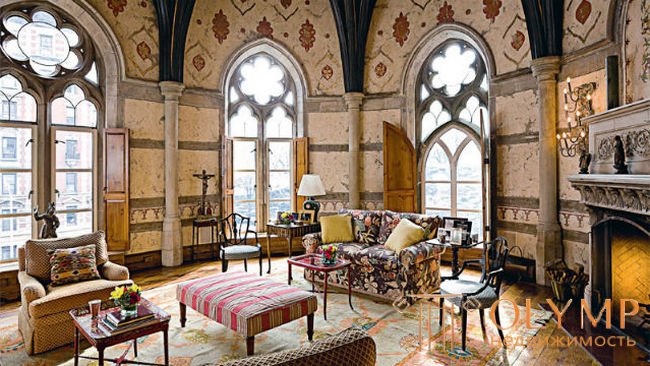
Gothic style (2 half. XII-XV centuries.). The style of a complex psychological state, he became the embodiment of the entire period of the Middle Ages in the understanding of modern man.
Gothic is mainly an architectural style, but in the interior design it is characterized by very significant differences from other styles, its own and “incomparable" face ”: the wooden walls play an active role in the Gothic interior. , oak beamed ceilings with girders and secondary beams.

The windows in the Gothic public and residential buildings become larger, they acquire, as well as in the churches, stained glass. Window binders and color glazing gave the interior a very special character. The dimensions of the glasses themselves are also increasing. In addition to the connection with lead stripes, they are directly associated with stone window covers. Colored transparent mosaic is clearly being supplanted by painting on glass.
Stone slab floors most often layed on a chessboard, but sometimes they also produced another complex woven pattern.
An important element of the decoration of the interior of public and residential buildings was the fireplace, which usually ended in a pyramidal cap, sometimes reaching the level of overlap. His hole was framed by profiled rods. In the upper part of the fireplace and on its sides, in the corners, shelves were made on which dishes and other objects were placed.
In the Gothic period, the types of furniture multiply, but the main role still belonged to coffer chests arranged along the walls; having wooden straight backs, the latter played the role of benches and sofas. In addition to the chairs, the chairs were large and hard, with straight, high backs that resembled episcopal thrones rather than ordinary seats. The prominent place in the rich houses was occupied by wide beds in the bedrooms, placed on a dais, having four profiled columns in the corners that supported a flat canopy, fringed with fabric with scallops or frills. Sometimes the canopy acquired a more complex form such as the conical outline of the tent.
There are large and heavy cabinets, cupboards for dishes, "shelves" with shelves and screens - especially in the bedrooms.
Gothic furniture is characterized by a diverse use of carving, thin, mostly embossed, sometimes slotted, using motifs typical of the architecture of this time - lancet arches, forming arcades intertwining or overlapping each other. Complicated in the figure, this thread turns into a peculiar texture that covers the entire surface of the cabinet, chest or chair back.
In the decoration of interiors, fabrics take on special significance. The decorative solution of some interiors, judging by the iconographic materials, was based more on draperies than on furniture. In some cases, the walls of the living quarters were entirely covered with colored matter, for example, dark green or crimson velvet, as well as cloth. From the middle of the 14th century, woven carpets, trellis with thematic compositions and ornamental motifs, began to be produced.
A certain role in the Gothic interior was played with dishes - jugs, trays, dishes, a mug, etc. They were exhibited on tables, shelves.

Что бы оставить комментарий войдите
Комментарии (0)